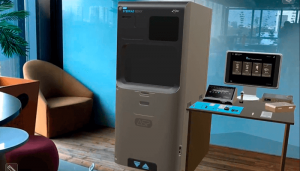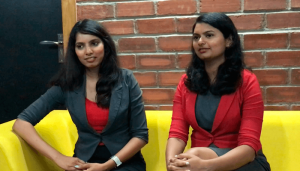This medtech startup gives you an immersive experience by letting you see and feel complex medical equipment remotely. In an edited conversation with the CEO of NexRea, Dr. Ramya Gujjula, we find out how it all began, what they do and where they are headed.
The best ideas don’t always come in the shower. Science has proven that boredom or mundane activities can spark the creative genius in you. Ask Dr. Ramya Gujjula. Describing herself as “Doctor by education and training but not by practice”, she is now an entrepreneur by choice. It all began when after a decade of corporate work experience in the healthcare sector, she began mulling over how corporate training could be enhanced. “I was working with Life Sciences companies across the globe, specifically with their training divisions and developing training content alongside subject matter experts,” she says. Discovering a void in innovative training, she says that she felt a compelling need to disrupt the training space.
When she quit her job to start up, she found a willing partner in her sister, Priyanka Gujjula. Priyanka is an architect with an MBA from Australia. Explaining how it seemed like the natural thing to do, Ramya says, “We have a creative family background. Our father, Ramana G.V is a renowned artist, writer and journalist in the Telugu literature industry. Coming from such a setup, we wanted to marry creativity with technology.” Brainstorming for something novel and innovative led to an augmented reality product. “The first of its kind, way back in 2016,” reminisces Ramya. And with that NexRea, an abbreviated form of Next Generation Reality, was officially born.
What Is It About
While Augmented and Virtual Reality technologies in the entertainment industry such as gaming up the fun quotient, NexRea’s AR solution has immense potential in the healthcare space. NexRea’s product simulates any kind of medical device or equipment. Terming it as a customizable end-to-end solution that can help in conducting virtual demos, training as well as servicing of sophisticated equipment, Ramya demonstrates how it works. She brings to screen a complex CT scanning machine and ‘walks’ right in the middle of a virtual demo. A personalized on-demand tool that hospital staff from clinicians to technicians can play with is certainly handy. “Imagine the costs that can be cut when instead of physically travelling to the location where the machine is kept or transporting it to where a hospital is located, you can access all its features at your fingertips and get a sense of the way it operates!,” remarks Ramya. Not just useful in marketing and sales, the solution is especially cost-effective when it comes to after-sales support in the form of installing, maintaining and repairing medical equipment remotely. “We typically do a 3-day training first and call the tool a ‘Day 4 to Day Infinity mobile app’. This is because it can help the end-user forever,” says Ramya.

Current Market
All medical equipment manufacturers are potential buyers of this solution. With the first prototype presented to GE Healthcare, it’s no surprise that GE forms their largest customer base. Other giants like Johnson & Johnson, Horiba Medical and others have followed suit. “We’ve managed to penetrate into the US and the South Korean markets too,” says Ramya. With a lot of their tech being developed out of the US, it’s not surprising. But Korea? “South Korea happened thanks to the US,” smiles Ramya and offers an explanation. The startup helped develop a game-based solution for Prof. Paul Kim of Stanford University who is known for his award-winning online tool called SMILE – Stanford Mobile Interactive Learning Environment. It was thanks to Prof. Kim that they were introduced to other stakeholders in South Korea in the K-12 education space. The formal foray into South Korea however began after they attended a K-Startup Grand Challenge, an accelerator program in Korea.
Future Prospects
Though the venture was kick started with a dedicated focus on healthcare devices, they were approached with requirements from other sectors too such as the tourism and oil and natural gas industries. Ramya quickly adds to say, “We realised that building expertise and being looked upon as experts in a single domain is much more valuable than spreading ourselves thin across various domains.” That said, even though the business use cases may be different, the augmented reality tech is relevant to other industries such as the automobile industry which is what they want to explore next. Within the medical equipment industry itself, NexRea is poised in the direction of servicing which is showing a lot of potential waiting to be addressed.
Funding
Initially bootstrapped, as NexRea gained traction with healthcare giants such as GE and Johnson & Johnson, they generated enough revenue to take their startup forward. The current 20-member strong team is spread across Hyderabad, San Francisco and South Korea. “We haven’t reached out for external funding until now. When we have a strong foundation that is scalable, that’s when we will reach out,” says Ramya.
Soul Sisters
Busting the myth that going into business with family is avoidable, Ramya is all praise for the partnership she has with her sister, Priyanka. “If there are siblings, there’s bound to be a difference of opinion. For us, this difference turned out to be more complementary in nature because that’s how we have been brought up too. Our interest areas are different. There’s no conflict in terms of what we are trying to say or do. I’m the Chief Executive Officer and Priyanka is the Chief Creative Officer.” With such a designation, Ramya affirms that Priyanka is the one with the creative head and more on top of things at the tech front.” She’s constantly on the lookout for newer and affordable technology and often experiments with it.” While typically making sure not to get into each other’s area of expertise, when overlaps are inevitable during business decisions, they try to make it as objective as possible. “However, no two people are the same, let alone siblings. And if there is a conflict of opinion, we make our peace way too easily compared to other co-founders who may take longer to get back affecting business decision,” remarks Ramya with a smile.

IIITH-Ojas Community
As part of the Ojas Medtech BioNest, Ramya calls it a boon since it is an accelerator specific to the medtech community. “The healthcare space itself is a niche one. There are other medtech accelerators in Hyderabad but I think Ojas has its own specialty, by virtue of it being a part of IIITH’s large network.” Speaking of Radha Rangarajan who heads the medtech incubator, Ramya is in awe and remarks that she is a true entrepreneur who brings in a lot of domain knowledge. “We respect her a lot”. Radha in turn has this to say of the upcoming startup, ”Nexrea is developing unique solutions for improving efficiencies in sales and service cycles for equipment manufacturers. When products are large and complex, which is often the case with medical equipment, a virtual reality solution makes the process of visualizing and handling the equipment in the pre-sales period convenient and simple. What makes Nexrea’s products particularly interesting are the vivid and detailed views, together with the ability to touch and feel, that their solutions offer”. With a tailored, custom-built app, the startup is certainly disrupting the current sales, training and servicing space of the medical device and equipment sector.


